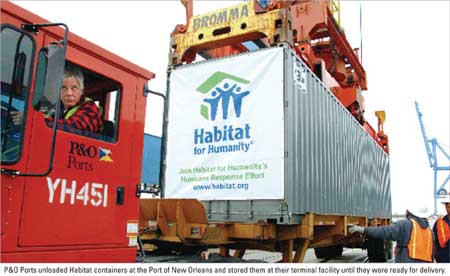By Peter A. Buxbaum, AJOT

Habitat for Humanity is a well-known faith-based organization that has, since its founding in 1976, built or rehabilitated over 150,000 housing units for needy families around the world. So it's not surprising that when the organization sought to provide relief to victims of Hurricane Katrina, it was able to enlist such partners and sponsors as NBC television, Time Warner, Whirlpool, Dow Chemical, and Citigroup.
NBC's Today Show covered the organization's efforts, called Operation Home Delivery, on a regular basis. Habitat volunteers were allowed to erect a home in front of NBC's headquarters at Rockefeller Plaza in New York and rename it Humanity Plaza for a week. All of this was organized by Habitat's public relations staff, including events coordinator Lesli Nadolski. But when Habitat had the idea of floating houses down the Mississippi River by barge to New Orleans, Nadolski learned that organizing logistics and coordinating an event were not exactly the same.
'Operation Home Delivery didn't exist until after the hurricanes hit,' said Nadolski. 'There was a great need for housing that came about in response to Hurricane Katrina.'
The project started with Habitat volunteers coming out to frame homes toward the end of September 2005 in Los Angeles and Jackson, Miss. Those frames were loaded on trucks on shipped to the gulf coast, to be erected on foundations. Penski was one of the main carriers involved in those movements.
'Then the idea came about to leverage the public interest in the project to provide more homes by building them and sending them down the Mississippi River by barge,' Nadolski explained. 'It seemed like a great opportunity to do something unique.'
That is what led Nadolski to head up to St. Paul, Minn., to work with Habitat affiliates there who were already hard at work framing homes. 'That's when I started learning all I needed to know about the river industry,' she said. 'I had no prior experience in transportation. I am an events planner by trade.'
The first thing Nadolski learned is that you don't just order a barge the way you'd hail a taxi. 'We thought we could simply load a barge on Monday in Minneapolis and greet it on Friday in New Orleans,' she said. 'There was a big learning curve involved.' Among other things, Nadolski found out the difference between a deck barge and a hopper barge, how long the transit time is from the upper Mississippi to New Orleans, the role weather plays in transit time, how barge crews work, and the fact that barges transit in convoys of thirty or more carrying different cargoes for various customers.
Two of the leading barge companies on the Mississippi, normally competitors, Teco Barge Line and Ingram Barge Company, worked together to help Operation Home Delivery. 'They made everything very easy for us and showed a lot of patience,' said Nadolski. 'They handled a lot of the details, including getting containers, barges, and cranes to where we needed them. They really just offered a lot of coordination and donated a lot of service to us.'
On the delivery end, Habitat enlisted the aid of the Port of New Orleans. 'We were intermediaries in getting P&O Ports involved,' said Paul Zimmerman, Port of New Orleans operations manager. 'We also called trucking companies to get them involved.'
'The Port of New Orleans called different entities and said that they have this particular initiative and asked if anyone was interested in contributing time and donating resources,' added Terry White, vice president of P&O Ports in New Orleans. 'When we saw what it was all about we said we were interested in doing whatever we can to help.'
P&O Ports unloaded nine Habitat containers in the Port of New Orleans and stored them at their terminal facility until they were ready for delivery. P&









